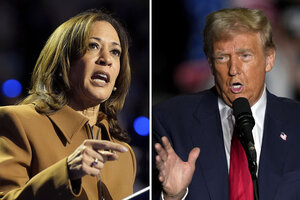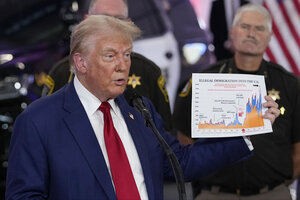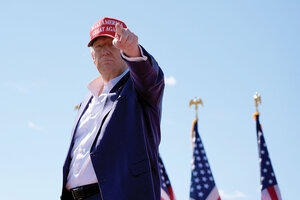Harris and Trump spar over economic impact of taxes and tariffs
With the economy consistently ranking as the top issue on voters’ minds, Kamala Harris and Donald Trump are locked in a fierce contest of messaging – each portraying their own policies as recipes for prosperity and their opponents’ as a threat to financial security.
In some ways their plans are actually similar. Both major-party candidates want to keep taxes low for the vast majority of Americans. Both favor efforts to produce more goods at home rather than importing them. And in pursuing their policies, both largely ignore an ever-rising national debt.
But key differences aren’t hard to find, notably on the role of tariffs, tax rates for wealthy people, and the treatment of immigrants. Here’s an overview of what Republican presidential nominee Mr. Trump and Democratic nominee Ms. Harris propose on the economy.
Tax policies are a centerpiece, in part because whoever wins the White House will oversee what comes next after former President Trump’s tax cuts, from his previous administration, expire after 2025, says Erica York, senior economist at the Tax Foundation, a tax policy nonprofit.
Kamala Harris has pledged to:
- Not raise taxes on personal incomes below $400,000.
- Raise the top personal income tax rate from 37% to 39.6%.
- Expand the child tax credit and earned income tax credit.
- Create an “America Forward tax credit” to invest in strategic industries.
- Raise the tax rate on long-term capital gains.
- Create a new tax on unrealized capital gains for people with a net worth of $100 million or more.
- Raise the corporate tax rate from 21% to 28%.
- Expand the small-business tax credit from $5,000 to $50,000 to encourage people to start new businesses.
- Respect Federal Reserve independence to set monetary policy.
Donald Trump has pledged to:
- Extend the expiring provisions of the Tax Cuts and Jobs Act, which he signed in 2017.
- Cut the corporate tax rate from 21% to 15%, a change that applies only to domestic production.
- Eliminate taxes on Social Security benefits.
- Eliminate taxes on overtime work.
- Impose a 10% to 20% tariff on all imports, and a 60% tariff on imports from China.
- Seek to deport unauthorized immigrants, reducing the overall number of workers and consumers in the economy.
- Replace Jerome Powell as Federal Reserve chair. Mr. Trump has also said that he thinks the U.S. president should have some say on how the Fed sets interest rates, and he publicly pressured Mr. Powell on policy during his White House term.
The candidates also have policies on the big issue of housing, which we’ll cover in a separate story.
What the Trump and Harris tax plans would mean for Americans
With tax policy, what presidents get – versus what they want – depends crucially on Congress. If the opposition party controls even one house of the legislature, change is difficult.
Distribution of their proposed tax cuts would be starkly different. As with his 2017 tax cuts, former President Trump’s new plan gives the most money to the highest-income households: $376,910 apiece on average to the top 0.1% versus $320 to the bottom fifth in income distribution, according to estimates by the Penn Wharton Budget Model.
Under Vice President Harris’ plan, it’s the reverse. The bottom fifth of households would get the most money, an estimated $2,355 each, while the top 5% of households (those making well over $300,000 a year) would see a tax increase, with the top 0.1% (those making well over $3 million a year) paying an extra $167,255.
These estimates come with some caveats but give a general picture.
Tariffs: taxes by another name?
For Mr. Trump, the biggest unknown is what he would do with tariffs. He has stated he wants to impose a 60% tariff – or surcharge – on all Chinese imports and a 10% to 20% tariff on imports from everywhere else to boost U.S. manufacturing jobs.
An across-the-board tariff would be a radical departure from current economic policy. Many economists criticize that strategy, saying that whatever U.S. job growth tariffs might spur would be swamped by the negative consequences of higher consumer prices and slower economic growth.
The Peterson Institute for International Economics, a Washington think tank, estimates that the Trump tariffs, if fully implemented, would cost the typical household up to $2,600 next year.
Tariffs also invite countertariffs from the targeted countries, making it harder for U.S. firms to export. China retaliated in the face of stiffer tariffs under both Presidents Trump and Biden. And in the 1930s, the Great Depression deepened after President Herbert Hoover initiated what became a trade war with other nations.
What their plans would mean for federal deficits
The combination of the Vice President’s pro- and anti-growth tax proposals would increase the federal deficit by $2 trillion over 10 years, according to Penn Wharton estimates. Mr. Trump’s lighter taxes on business might spur more economic growth. But they would also add $4.1 trillion over 10 years to the national debt, the model finds.
And other models differ on whether Mr. Trump’s policies would raise economic growth. Weighing the likely tariff and immigration moves alongside other policies, Goldman Sachs estimates lower growth under a Trump administration than under current policies. (Its estimate envisioned a slowdown in immigration, not the larger disruption to labor supply that economists say would accompany mass deportation, a proposal that experts say would be hard to carry out quickly in practice.)
The Trump tariffs could raise substantial revenue for the federal government, even as they create extra costs for consumers and raise the risk of a trade war.
“The range of [economic] uncertainty is much narrower with Harris than it is with Trump – maybe a little more growth, maybe a little less growth,” says Howard Gleckman, a senior fellow at the Tax Policy Center. “With Trump, you’re looking at this wide variation, and you could have very serious negative consequences.”















